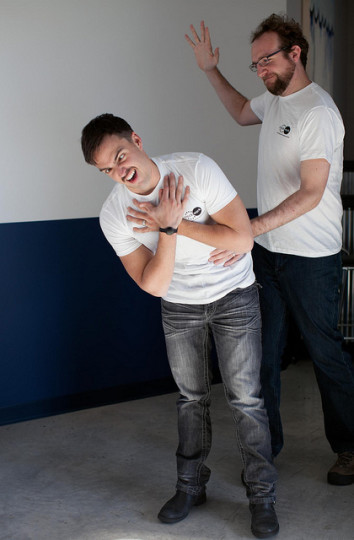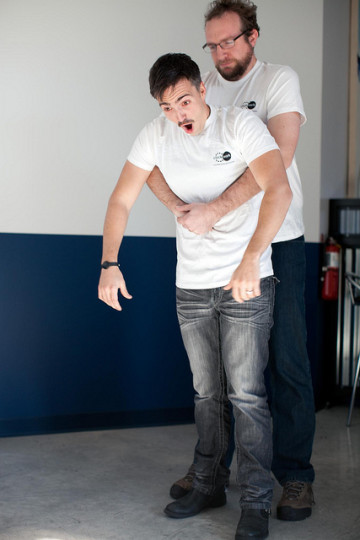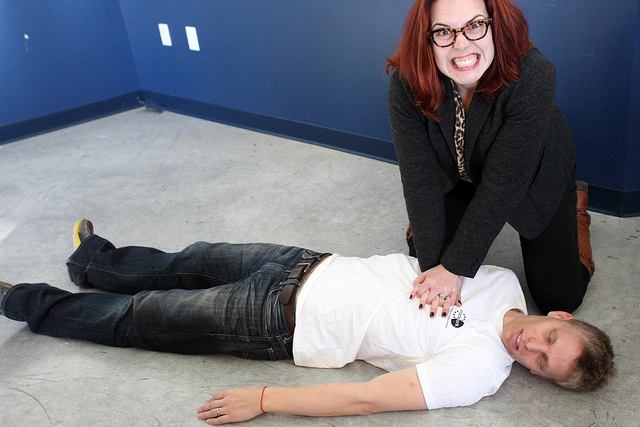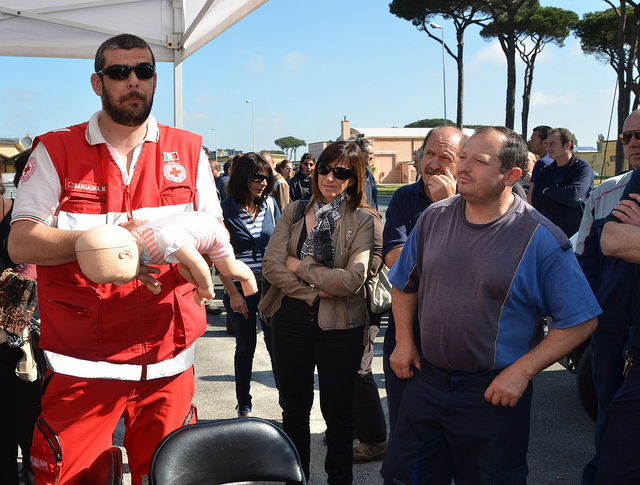Nobody at the food court who watched the young lady run towards the wash-room cared to help. She collapsed before reaching the wash-room. Nobody could identify that she was choking on the food. Either none of them were aware of the first aid steps for choking or else they simply didn’t care.
Dr Lakshmi M Mohan, a young psychiatrist working at the Government Mental Health Centre Thrissur, was the victim here. She was at this popular shopping mall with her family on that dreadful evening. The unfortunate tale of events that followed could have been easily prevented if someone in the vicinity had the know-how of providing first aid for choking.
After collapsing, there was no urgency from the fellow shoppers or the managers at the shopping mall to give first aid or at least take her to the hospital. According to this news article on the Malayala Manorama, it took 11 minutes to bring her down from the third floor of the building to the ground floor. As there was no ambulance facility at the shopping mall, further delay was made in rushing the lady to the hospital which was just 2 kilometres away from the mall. Nobody at the mall even cared to arrange a vehicle it seemed! Almost 25 precious minutes were lost while taking her to the hospital.
At the emergency department of Amala Medical College, she was declared as “brought dead”. A precious life lost simply because of ignorance and lack of basic emergency services.
This article is about choking, it’s causes, symptoms, treatment and first-aid.
What is Choking?
Choking happens when a person’s windpipe (airway) gets blocked suddenly. The blockage could be either partial or complete making it difficult for the person to breathe. The blockage can be either due to foreign bodies which are swallowed by children or in adults due to food. If left untreated or if no first aid is provided promptly, this can become a fatal situation. This is because, the human brain cannot live without continuous oxygen supply. That is why persons become unconscious within five minutes of complete airway obstruction.
What are the common Causes of Choking?
Choking can happen to any person. There are a few instances where the chances of choking are higher. They can be listed as follows :
Food – Choking on food is the most common cause so far. Examples of food items which can result in choking include candies, meat, bones, nuts and chewing gums. Gums are very notorious to cause choking especially in children and have already taken the lives of many. Following good table manners greatly reduces the chances of choking on food. Chewing the food properly before swallowing is very important. Avoid talking, laughing,playing, walking or any other kind of physical activity that involves heavy breathing while eating food. This should be particularly taken into consideration while feeding young children. Relax, and enjoy the food you eat. Don’t eat in a hurry. Alcohol consumption before eating can make you lazy to chew the food and thus the chances of choking are increased.
Foreign Bodies – Examples of foreign bodies that can easily be swallowed to result in choking includes dentures, pearls, parts of toys, buttons, etc. Make sure that such items are beyond the reach of your kids.
How to identify Choking?
Mild Choking – The person usually coughs several times in an attempt to dislodge the obstructive substance. The person can talk, cry and breathe.
Severe Choking – This is the most dangerous type of choking. Here, the windpipe obstruction is almost complete. The person finds it difficult or practically impossible to breathe. They usually grasp their throat in a panicky way. The person who is choking may not be able to cough, cry or talk. Within a few minutes, the facial skin, lips may turn bluish in colour. If proper first aid is not provided, the choking person may lose consciousness, collapse and eventually die.
What to do when you find someone Choking?
The first aid for choking depends on it’s severity.
#1 If the person can talk, cry and breathe, encourage him to cough repeatedly.. Most of the time, they will be able to remove the blockage by themselves. If there is any food particles still in their mouth, ask them to spit it out. Don’t put your fingers in their mouth to remove the obstructing substance. The panicked person might accidentally bite you! If coughing doesn’t seem to help, try the following without wasting time :
#2 Call for help, dial 112 (India) or 102 (for ambulance).
#3 Back Blows

Aim – To dislodge the airway obstruction by blowing on the back of the choking person.
Position – Make the person stand up and lean forward. Stand behind the person to one side.
Procedure – With the heel of your hand (part of hand between the palm and wrist), blow on the back side of the person (between the shoulder plates) five times. Check if the blockage has been removed or not. If not, continue to the next step.
#4 The Heimlich’s manoeuvre (Abdominal thrusts)

Aim – The idea is to produce an artificial cough in a person with severe choking in an attempt to remove the blockage.
Position – Stand behind the choking person. The person should be made to lean forwards a little bit.
Procedure – Place your arms around the waist of the choking person. Bend the person forward. Make a fist with your one hand and place it just above the person’s belly-button so that your thumb is pointing inwards. Place your other hand on top of your fist and in a sudden motion pull it upwards and inwards. Repeat the procedure for five times. Check whether the blockage has been removed. If the Heimlich’s manoeuvre is not helping, rush the person to the nearest hospital.
NOTE : Do not attempt abdominal thrusts on infants (baby aged less than one year) and in pregnant women.
In the meantime continue the cycles of giving 5 back blows and 5 abdominal thrusts.
#5 If the person becomes unconscious, and is not breathing, you’ll have to start giving cardio pulmonary resuscitation (CPR) with chest compressions and continue it till medical help arrives.

First Aid for a Baby who is Choking
In case of infants, the following changes should be noted :
#1 Call for help, dial 112 (India)
#2 Back Slaps

Position – Place the baby across or along your lap with face downwards. The head of the baby should be at a lower level. Keep the baby’s mouth open by placing your thumb and one or two fingers on either side of the jaw.
Procedure – With the heel of your hand slap between the shoulder plates. Repeat the blows and check whether the obstruction has been removed. Do not use your fingers to sweep the baby’s mouth unless you see the obstructing substance clearly. Or else, doing so might push the object further in.
#3 Heimlich’s maneuvre, (Chest thrusts)
Position – Place the baby with face upwards along your forearm and support the forearm on your lap. Hold the baby’s head with the palm of your hand in which the baby is held.
Procedure – Instead of abdominal thrusts, use your fingers to give sharp chest thrusts on the lower half of the baby’s breast bone. Do not use your fingers to remove the object from the baby’s mouth. Repeat the movement for up to 3 cycles.
#4 If the baby is in distress, not crying or breathing start CPR and continue till medical help arrives.
What to do after giving the First Aid?
After giving first aid, if the blockage has been removed, you’ll still need to take the person to the nearby hospital. This is because there might be some more food particles or objects at the opening of the windpipe. The doctor’s need to make sure that no object has been aspirated. Chances of aspiration pneumonia should be ruled out. If the person was unconscious, they should be definitely hospitalised even after the blockage has been successfully removed. Please don’t hesitate to take the person to the nearest healthcare facility if you really want to help them.
How to Prevent Choking?
I’ve already mentioned this briefly earlier in this article. But, such is the importance of the following precautions that I am mentioning it again :
- Follow healthy eating habits as listed in this article
- Do not eat in a hurry
- Chew your food properly before swallowing
- Avoid talking, laughing, joking, playing, walking with food in your mouth
- Keep an eye on your children while they are eating
- Don’t give gums to your kids
- Don’t eat when you are lying down
- Do not leave tiny swallowable objects lying around. Keep them out of reach of the children in your house.
- Cook the food especially meat properly to make it soft and easily chewable
- Avoid drinking alcohol before eating.
- Make sure that your dentures are not loose-fitting
The incident I mentioned at the beginning of this article happened in Kerala, a state which is highly praised for the high literacy rates. Dr Lakshmi’s life would’ve been saved only if someone had given her the first aid for choking. I sincerely wish that such an unfortunate incident doesn’t happen to anyone, let alone a doctor! Hope this article helped you understand what choking is and how to manage it properly. Share this article with your friends and family too.